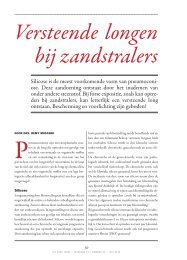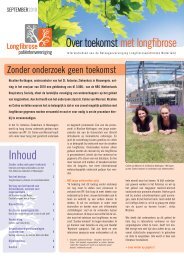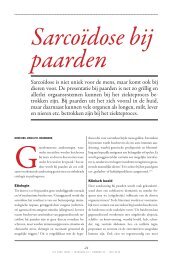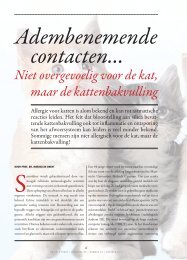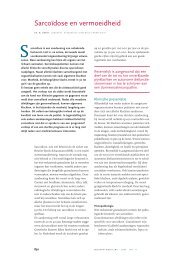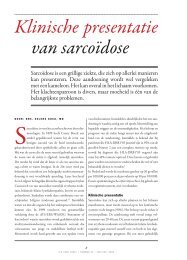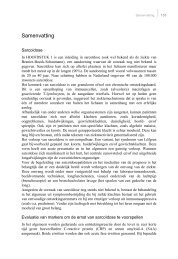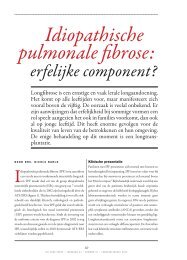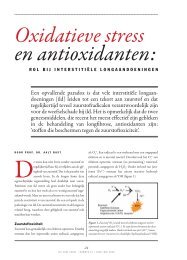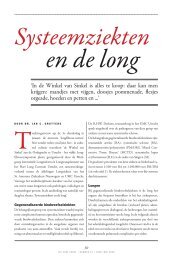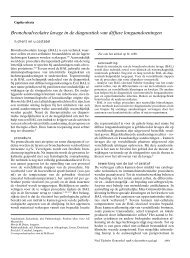Interpretation of bronchoalveolar lavage fluid cytology - ILD care
Interpretation of bronchoalveolar lavage fluid cytology - ILD care
Interpretation of bronchoalveolar lavage fluid cytology - ILD care
You also want an ePaper? Increase the reach of your titles
YUMPU automatically turns print PDFs into web optimized ePapers that Google loves.
<strong>Interpretation</strong> <strong>of</strong> BALF <strong>cytology</strong><br />
A computer program using BALF analysis results as a<br />
diagnostic tool in interstitial lung diseases<br />
Marjolein Drent<br />
Maarten A.M.F. van Nierop<br />
Frank A.Gerritsen<br />
Emiel F.M. Wouters<br />
Paul G.H. Mulder<br />
Abstract<br />
Background-Recently, we showed that it is possible to distinguish between three common interstitial lung diseases<br />
(<strong>ILD</strong>) with similarities in clinical presentation by using a number <strong>of</strong> selected variables derived from <strong>bronchoalveolar</strong><br />
<strong>lavage</strong> <strong>fluid</strong> (BALF) analysis. The aim <strong>of</strong> this study was to develop a more general discriminant model, based on<br />
polychotomous logistic regression analysis.<br />
Study design-The 277 patients involved in the study belonged to diagnostic groups with sarcoidosis (n=193),<br />
extrinsic allergic alveolitis (EAA; n=39), and idiopathic pulmonary fibrosis (IPF; n=45). The diagnosis had been<br />
established independently <strong>of</strong> the BALF-analysis results. Results-The variables used to discriminate among these<br />
patient groups were the yield <strong>of</strong> recovered BALF, total cell count, and percentages <strong>of</strong> alveolar macrophages,<br />
lymphocytes, neutrophils, and eosinophils. In order to test the predictive power <strong>of</strong> the logistic model, we used 128<br />
patients having sarcoidosis (n=91), EAA (n=5), or IPF (n=32) from another hospital. In this test set the agreement <strong>of</strong><br />
predicted with actual diagnostic-group membership was the same as in the learning set in which the logistic model<br />
was fitted: 94.5% <strong>of</strong> the cases were correctly classified.<br />
Conclusion-A validated computer program based on the polychotomous logistic regression model can be used to<br />
predict the diagnosis for an arbitrary patient with information provided by BALF-analysis, and is thought to be <strong>of</strong><br />
diagnostic value in patients suspected <strong>of</strong> having <strong>ILD</strong>.<br />
Am J Respir Crit Care Med 1996; 153: 736-741.<br />
Introduction<br />
Bronchoalveolar <strong>lavage</strong> (BAL) has the advantage <strong>of</strong> having a high sensitivity for the diagnosis and evaluation <strong>of</strong> a<br />
great variety <strong>of</strong> inflammatory processes in the lung, particularly interstitial lung diseases (<strong>ILD</strong>) [1-4]. Common<br />
clinical, radiographic, and pathophysiologic features form the basis for collectively referring to this complex group <strong>of</strong><br />
disorders as <strong>ILD</strong>. Despite a thorough history and physical examination, blood and serologic tests, imaging<br />
procedures and physiologic tests, a specific diagnosis most <strong>of</strong>ten requires the use <strong>of</strong> specialized procedures such<br />
as fiberoptic bronchoscopy with BAL, transbronchial biopsy, and thoracoscopic or surgical lung biopsy [2]. Since<br />
BAL, a safe and minimally invasive procedure, enables cellular and noncellular components from small airways and<br />
alveolar spaces to be obtained and examined, it may replace more invasive diagnostic procedures in the evaluation<br />
<strong>of</strong> <strong>ILD</strong>. In addition, many studies employing BAL have resulted in major advances in understanding <strong>of</strong> the cell<br />
biology <strong>of</strong> the lung and <strong>of</strong> the pathogenesis <strong>of</strong> many pulmonary diseases [5-7]. Usually, <strong>ILD</strong> show an alveolitis characterized<br />
by an accumulation <strong>of</strong> inflammatory and immune effector cells within the interstitium and the alveolar<br />
spaces. The type <strong>of</strong> inflammatory cells in the lower respiratory tract may vary among the various <strong>ILD</strong>, and helps to<br />
confirm the diagnosis [1,3,6,8]. Excess activated, proliferating T-lymphocytes in the BAL <strong>fluid</strong> (BALF) are associated<br />
with granulomatous diseases such as sarcoidosis and hypersensitivity reactions such as extrinsic allergic alveolitis<br />
(EAA) [9-11]. However, the composition <strong>of</strong> lymphocyte subpopulations in BALF differs in these disorders. EAA is<br />
mainly characterized by a low CD4 + /CD8 + (helper:suppressor) ratio [9,10]. In contrast, a high CD4 + /CD8 + ratio is frequently<br />
found in sarcoidosis [1,6]. Also, in EAA, a mild increase in polymorphonuclear neutrophils (PMNs) and mast<br />
cells can be found shortly after the inhalation <strong>of</strong> antigen [8,12,13]. Moreover, the presence <strong>of</strong> plasma cells in BALF<br />
samples is highly suggestive <strong>of</strong> EAA [14]. Despite random increases in BALF lymphocytes, PMNs, and eosinophils<br />
in about two-thirds <strong>of</strong> IPF patients, there are no typical cellular BALF features <strong>of</strong> this disease [1,15,16].<br />
The predominant inflammatory cells obtained by BAL therefore provide a useful indication <strong>of</strong> the nature <strong>of</strong> the<br />
S<strong>of</strong>tware to evaluate BALF analysis. Drent et al. Am J Respir Crit Care Med 1996.<br />
1



